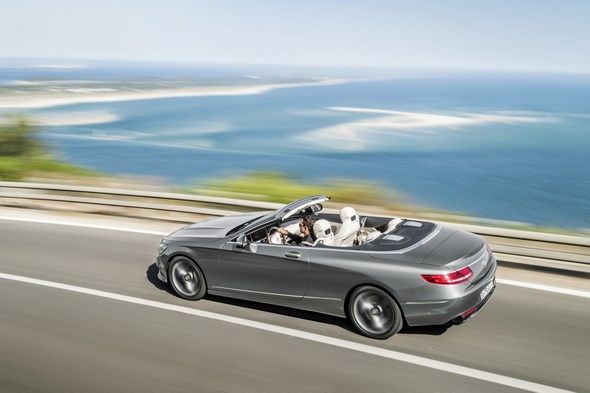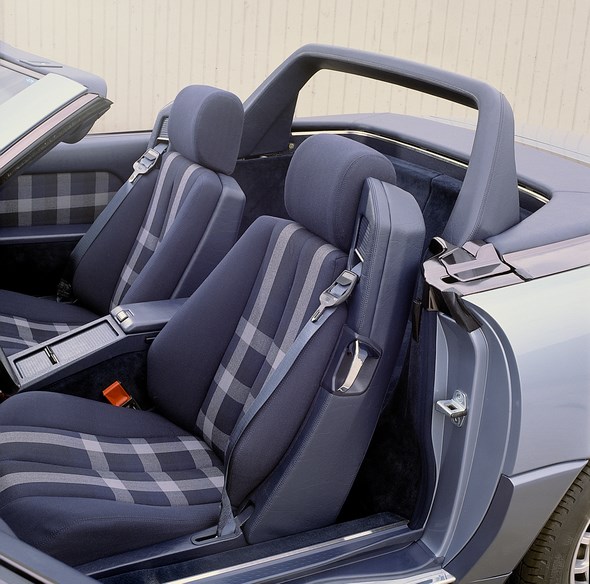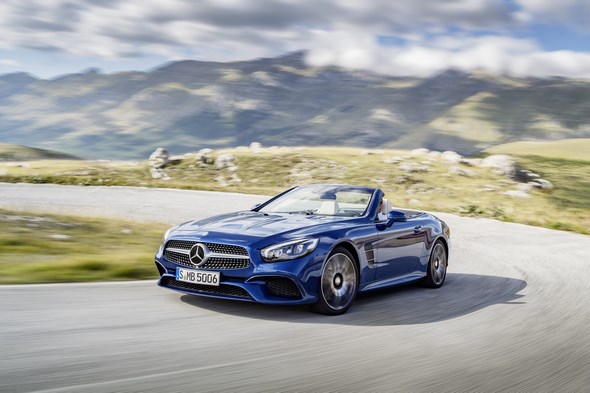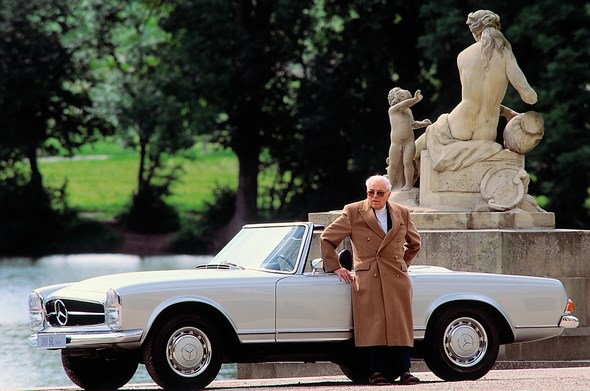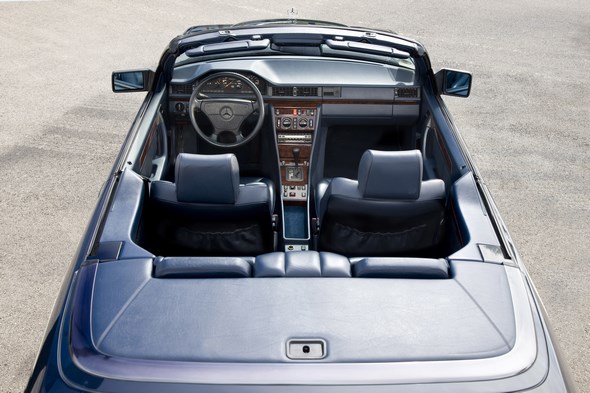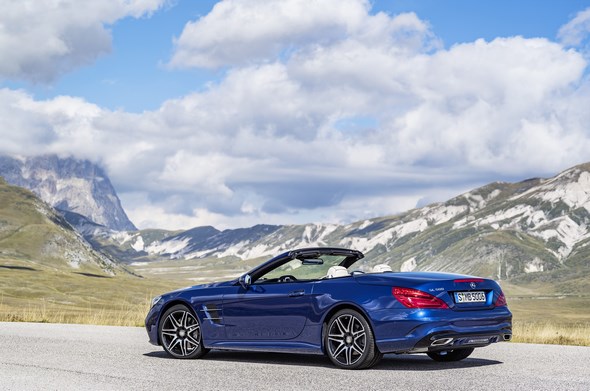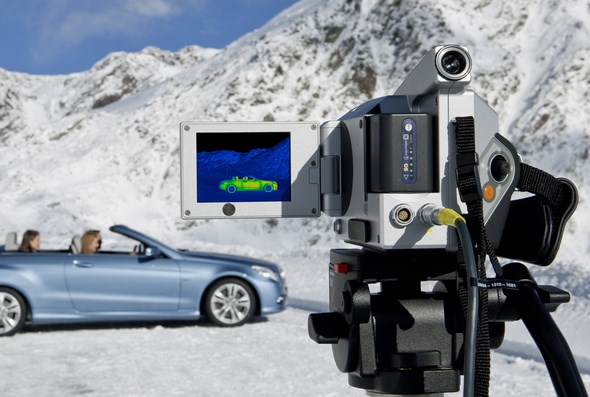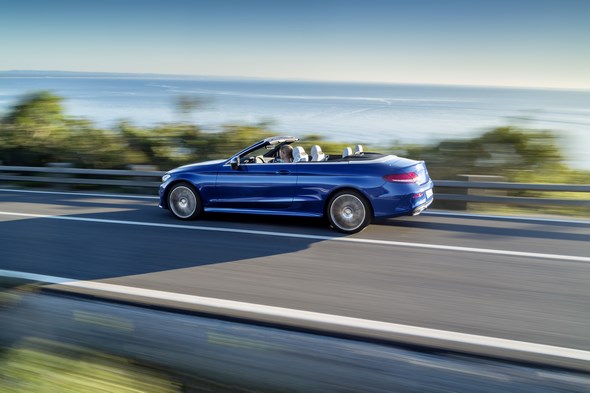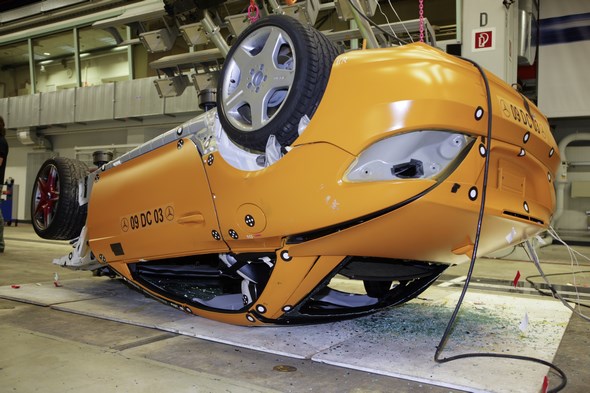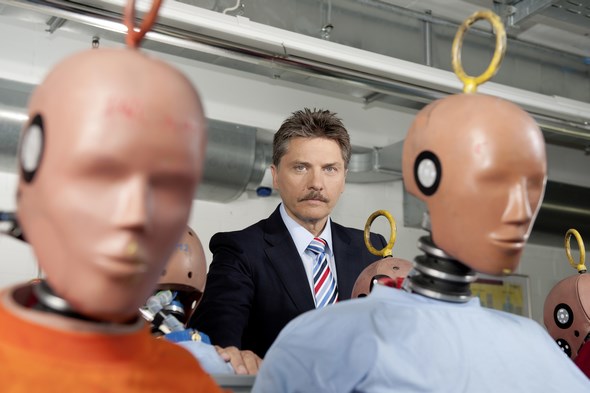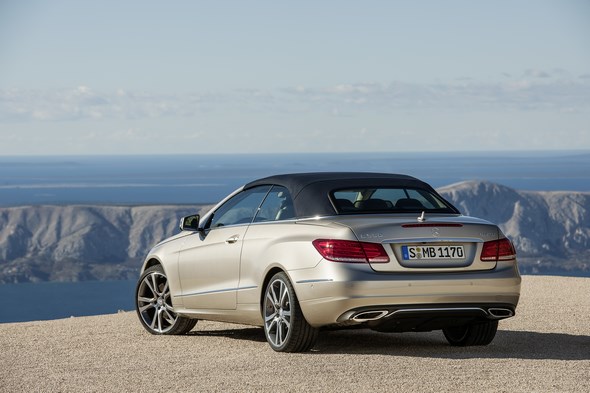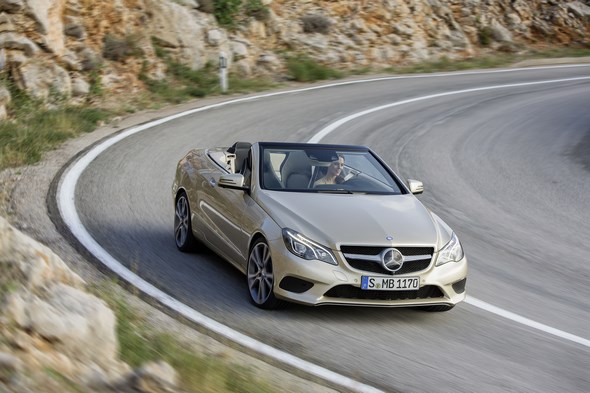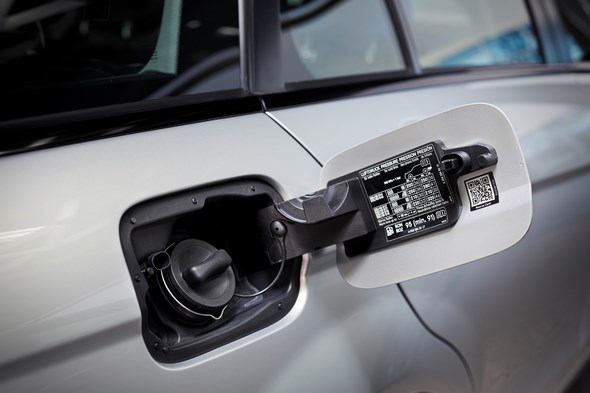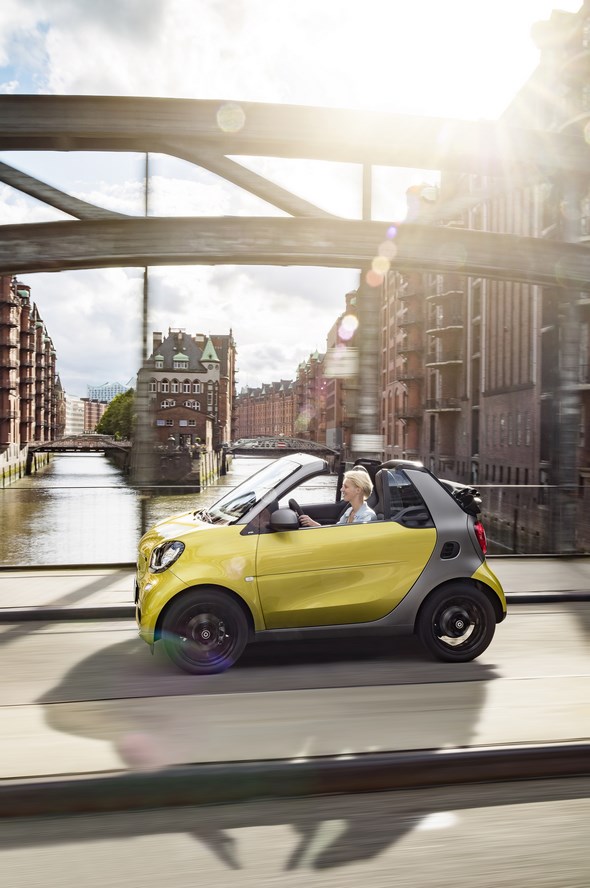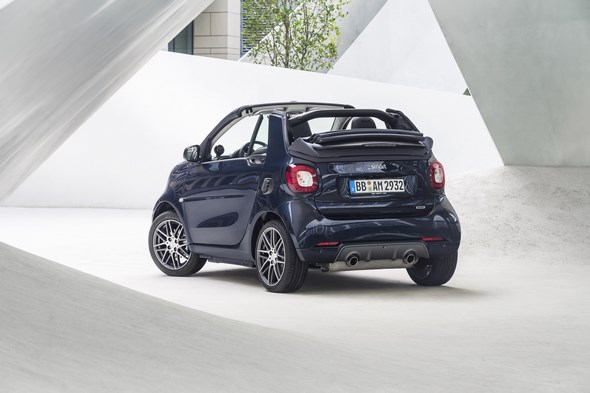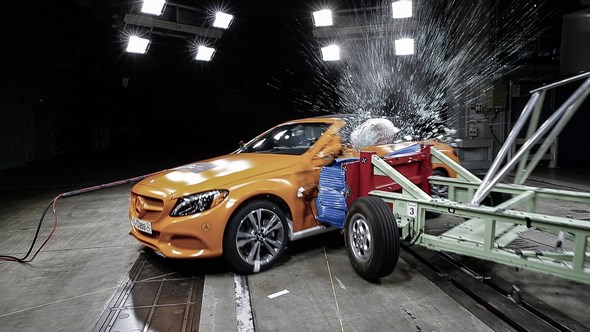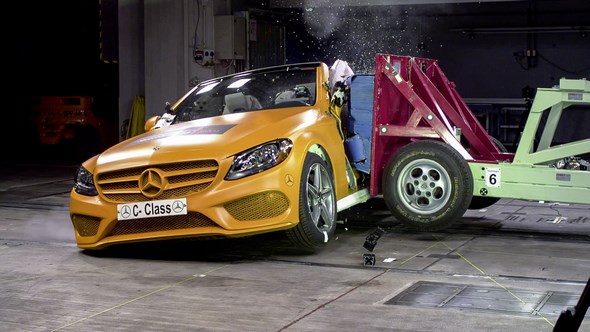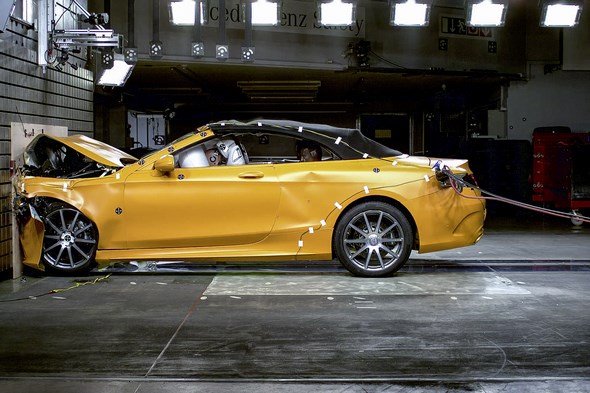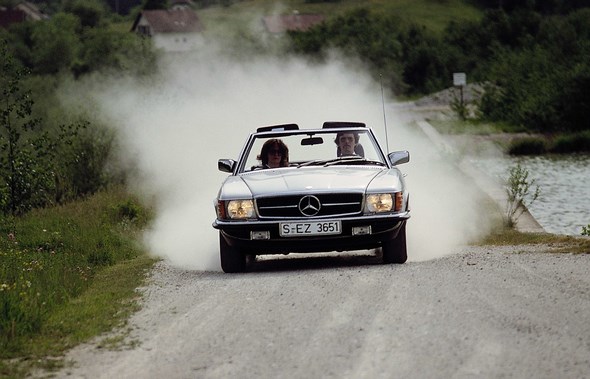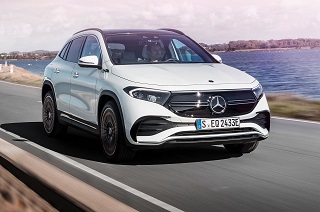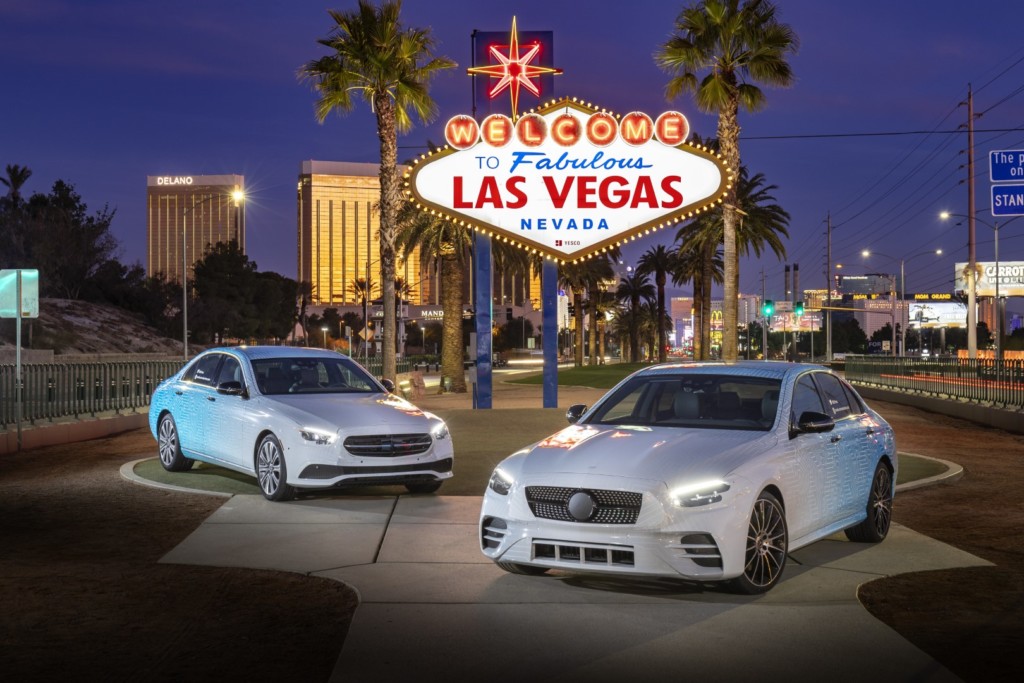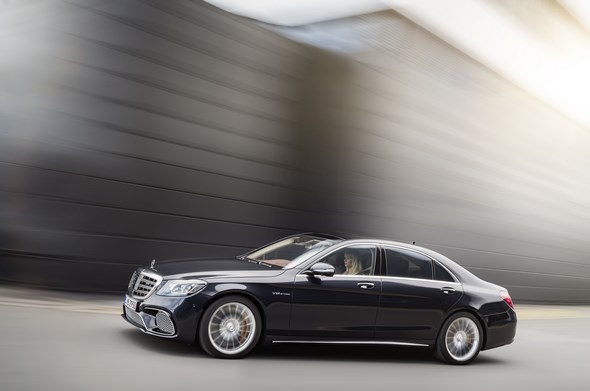Open-topped and safe

Relax and enjoy that dream car in safety
Stuttgart. 2016 is the year of dream cars for Mercedes‑Benz Cars. No other manufacturer offers so many and such young cabriolets and roadsters.
Or such safe ones: extensive systems on board provide active and passive safety to Mercedes‑Benz standards. Alongside the technologies familiar from the saloons, innovations specially developed for cabriolets and roadsters are used here.
These include the roll-over protection systems which secure survival space, and convenience systems such as AIRSCARF or AIRCAP, which ensure driver-fitness safety.
Preventive PRE-SAFE® protective measures, load-appropriate body structures and highly effective roll-over protection and restraint systems make the cabriolets and roadsters from Mercedes‑Benz Cars the safest vehicles in their segments. Like the closed model variants they meet the Mercedes‑Benz in-house safety requirements based on what actually happens in an accident.
Through components reinforced in a targeted manner and special support elements, the body-in-white experts at Mercedes‑Benz make sure that cabriolets and roadsters boast high structural safety even without a stabilising, solid roof. As well as crash safety, acoustic and vibration comfort, driving dynamics plus the hallmark Mercedes‑Benz longevity also benefit from this.
The Mercedes-Benz emergency call eCall also facilitates rapid help in an emergency. As part of Mercedes me connect the current Mercedes‑Benz models have this as standard.
Comfort is not an end in itself: innovations for driver-fitness safety
Relaxed travelling in the cabriolet or roadster is not just a luxury; it also means driver-fitness safety. For studies by the Customer Research Center (CRC) at Mercedes‑Benz show that certain comfort attributes have a direct influence on driver performance during and after a journey. Mercedes‑Benz innovations such as the neck-level heating system AIRSCARF and the automatic draught-stop system AIRCAP thus also provide safety as well as comfort during open-top motoring. This applies equally to the new intelligent climate control for cabriolets, which is currently available for the S- and C‑Class.
Intelligent Drive: less stress, safe driving
At Mercedes-Benz, Intelligent Drive stands for features such as the extensive range of assistance systems which make driving less stressful and safer. It goes without saying that they are also available for the roadsters and cabriolets, and one of the standard-fit features on board is the Active Brake Assist[1]. Apart from a visual distance warning and an additional, audible collision warning, the system has a situation-dependent brake boosting function which can help to prevent collisions.
If the driver does not react, autonomous braking can be initiated.
Further highlights are the proximity control DISTRONIC[2] with Steering Pilot[3]: The driving assistance system supports the driver in maintaining a safe distance from the vehicle in front and staying in the centre of the lane. Support in stressful situations is offered by the Active Brake Assist with cross-traffic function[4], which also includes situation-adaptive braking support where there is a risk of colliding due to crossing traffic.
As is the case with active and passive safety, Mercedes‑Benz is also concentrating on constructive precautions and comprehensive technical measures when it comes to anti-theft security. These include the latest-generation electronic immobilisers. And there’s more: whilst single-layer soft tops used to be easy to slit open, nowadays multi-layer (acoustic) soft tops and hardtops on roadsters offer much more resistance to knife attacks. Plus there are efficient anti-theft alarm systems.
Passive safety
Reinforced powers of resistance
Preventive PRE-SAFE® protective measures, load-appropriate body structures plus highly effective roll-over protection and restraint systems make the cabriolets and roadsters from Mercedes-Benz Cars the safest vehicles in their segments. Like the closed model variants they meet all the legal crash test regulations and the very discerning Mercedes-Benz in-house safety requirements which are based on what actually happens in an accident.
Through components reinforced in a targeted manner and special support elements, the body-in-white experts at Mercedes-Benz Cars make sure that cabriolets and roadsters boast high structural safety even without a stabilising, solid roof structure. As well as crash safety, acoustic and vibration comfort, driving dynamics plus the hallmark Mercedes-Benz longevity also benefit from this.
Two examples from very different segments of how the body-in-white structures are adapted to the special requirements:
- The smart fortwo cabrio additionally has a large steel cross in the sub-frame, two torsional bulkheads beneath the car at the front and rear plus an internal tube in the A-pillars made from high-strength hot-shaped steel.
- The S-Class Cabriolet bears a lavishly designed rear panel behind the rear seats. It consists of aluminium sections, the characteristic shape of which has earned this component the internal nickname “hockey goal”. Two shear panels, a magnesium rear wall and a cover consisting of aluminium sections assure this assembly of high rigidity. The rear wall is attached via two additional large cast aluminium parts to the side wall. There are also numerous reinforcements on the underfloor to enhance the four-seater cabriolet’s rigidity.
Highly effective roll-over protection and restraint systems
In addition to the high structural safety of the body, intelligent restraint systems offer optimum protection. On the roadsters, the seat belts are fed through a holder on the seat so that they are easily reachable and fit the body at the correct angle. The four-seater C-, E- and S-Class Cabriolets have belt feeders which make fastening the seat belts even more convenient. The belt feeder can also be extended by pressing a button on the centre console.
All cabriolets and roadsters are comprehensively equipped with the latest restraint systems. Pyrotechnic belt tensioners and force limiters are used on all seats. The airbag systems are geared to the equipment of the corresponding closed vehicle variants. But one special case is the cabriolet, where no windowbags can be used, as they require solid roof frames. In these cars the head protection is ensured in the first seat row by particularly innovative head airbags, which are integrated behind the door trim. Known as headbags, in a lateral collision they inflate on the impact side from bottom to top and can thus reduce the risk of a head impact onto the side surface of the car or onto intruding objects. For the second seat row Mercedes-Benz offers rear sidebags. These have been specially adapted to the structural features of the cars. As a world first the rear sidebag in the S-Class Cabriolet is designed as a head/thorax bag. This means that the shape of the bag has been designed so that the head as well as the thorax area can be covered by the protective system.
The roll-over is one of the accident constellations deserving particular attention on the cabriolet. An active roll-over protection system is a good solution for squaring the standards regarding the aesthetic appeal and safety of a cabriolet. The first active roll-over protection system celebrated its world premiere in the SL model series R129 (1989-2001). Today, enhanced variants are to be found on board all four-seater cabriolets and the SL as standard. If the sensors in the airbag control device detect an impending overturn, the roll-over protection system is deployed. Pyrotechnics supply the appropriate energy to allow the protective system to spring into action quickly behind the rear head restraints. The combination of a very stable windscreen frame and the roll-over protection system helps maintain a safe passenger compartment.
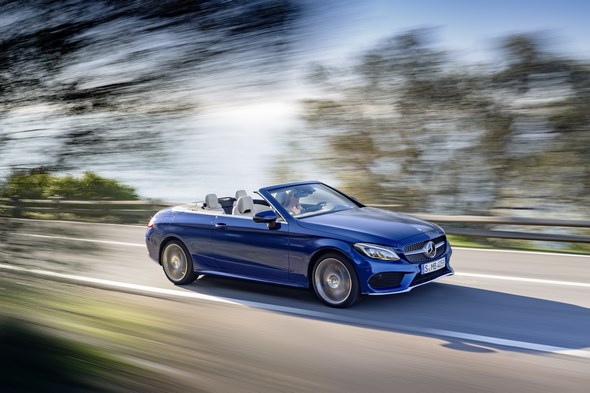
Preventive PRE-SAFE® protective measures
As a further safety highlight, it goes without saying that the anticipatory occupant protection system PRE-SAFE® is also available for the cabriolets and roadsters from Mercedes-Benz. If the system detects an acute risk of accident, as a reflex it activates preventive protective measures for the occupants, so that belts and airbags can unfold their full protective effect.
The functions of PRE-SAFE® have been constantly extended over the years. PRE‑SAFE® PLUS, for instance, offers protection if there is the risk of a rear impact. It warns the following traffic by activating the rear hazard warning lights at increased frequency and initiates preventive PRE-SAFE® occupant protection measures, such as the reversible belt tensioner, immediately prior to the impact.
If the vehicle is stationary, the brakes are locked to reduce the forward jolt, which reduces the forces acting on the occupants and the risk of secondary collisions.
Extensive crash test programme
The company’s crash tests exceed the number and complexity of the legally required tests: the current development programme for new ready-to-produce models comprises around 15,000 realistic crash test simulations and over 150 crash tests.
These include not just the approximately 40 different impact configurations designated for ratings and worldwide vehicle registration, but also particularly exacting crash tests such as the roof-drop test that are also carried out by the company for cabriolets and roadsters.
In the roof-drop test the body falls from a height of 50 centimetres at a slight incline onto the roof structure, so that initially only one of the two A-pillars is affected. In this load case the test regulation only allows one defined plastic deformation in order to secure the protective area.
Following an accident: Mercedes-Benz emergency call
Even if an accident has occurred, there are measures in place in a Mercedes-Benz cabriolet which can help reduce further dangers. For example, in a severe accident the engine is automatically switched off and the hazard warning lamps activated. In darkness, the crash-active interior lighting can go on automatically and afford the occupants better orientation. When the soft top is closed, slightly lowered front side windows can help ventilate the interior, and on cars with the Memory package the steering wheel can move upwards to make it easier to get out.
The current Mercedes-Benz models are equipped with the Mercedes-Benz emergency call as part of Mercedes me connect. An emergency call can be made automatically or manually. It is triggered automatically after deployment of one of the pyrotechnic belt tensioners or an airbag in the car. The service centre then establishes voice communication with the vehicle. If there is no response, it immediately alerts the nearest rescue service.
In every Mercedes-Benz there is a digital rescue card – a QR code in the filler flap. Via the Rescue Assist app the rescue services can find information as quick as a flash about the special model-specific features via their smartphone or tablet.
The latest update of the app facilitates three-dimensional views plus depictions in augmented reality. Rescue teams are thus able to locate even more quickly the places where they can, for example, use rescue shears without any danger. The 3D models can be freely rotated and scaled in the app. Depictions in augmented reality offer further advantages: all vehicle components are shown photorealistically, precisely and with extensive overlapping of the car involved in the accident – a big advantage for the rescue personnel at the accident site.
A further benefit of the Mercedes-Benz Rescue Assist app is that the underlying data can also be stored locally and therefore online access is not required at scene of the accident. So the app is also active offline, meaning that no time is lost during a rescue operation.
Under the microscope: driver-fitness safety
Hat and scarf are always on board
Savour the sun’s rays on your skin, feel the airflow and virtually taste the passing landscape – open-top motoring addresses all the senses. Mercedes‑Benz innovations such as AIRSCARF and the automatic draught-stop system AIRCAP thus also provide the highest levels of open-top motoring comfort even when the outside temperatures are less than cosy. But relaxed travelling in the cabriolet or roadster is not just a luxury; it also means driver-fitness safety.
Studies by the Customer Research Center (CRC) at Mercedes-Benz show that certain comfort attributes have a direct influence on driver performance and well-being during and after a journey. So comfort results in driver-fitness safety. Because a car driver who is mentally and physically fit has sufficient performance reserves to respond rapidly and correctly in critical traffic situations.
Relaxed travelling in cabriolets and roadsters from Mercedes-Benz has a long tradition, after all, ride comfort and NVH characteristics have always been some of the brand’s core values. Currently acoustic soft tops in the soft top models ensure a significantly perceptible reduction in the sound level in the vehicle interior compared with conventional fabric soft tops.
And, specially developed for cabriolets, the new climate control system responds to whether the vehicle is being driven with the soft top up or down. With the soft top down, the climate control system adapts by, for example, blowing warmer air onto the driver’s hands on the steering wheel and deactivating the air recirculation function. The intelligent climate control for cabriolets is currently available for the S-Class and C-Class and will in future ensure optimum climate comfort coupled with easy operation in all the open-top cars from Mercedes-Benz.
In addition to this there are innovations such as the neck-level heating system AIRSCARF (premiere in 2004) and the automatic draught-stop system AIRCAP (2010), which also enhance comfort and thus driver-fitness safety during open-top motoring. A hat and scarf are therefore always on board.
The neck-level heating system AIRSCARF is integrated into the backrests of the front seats and blows warm air out of outlets in the head restraints. AIRCAP consists of two components: an extending wind deflector with a net in the frame of the windscreen and a draught-stop behind the rear seats. The wind deflector raises the airflow, while the net increases the pressure level in the interior in a controlled manner, thus reducing the return flow, which is in turn slowed by the draught-stop and becomes more equal. This means that air movement in the interior is considerably reduced and a “sea of warm air” is created.
Here is an overview of the availability of AIRSCARF and AIRCAP:
| Model series | AIRSCARF | AIRCAP |
| C-Class | 547.40 euros Also included in the Cabriolet Comfort package (1249.50 euros) | 821.10 euros Also included in the Cabriolet Comfort package (1249.50 euros) |
| E-Class | 547.40 euros Also included in the Cabriolet Comfort package (1249.50 euros) | 821.10 euros Also included in the Cabriolet Comfort package (1249.50 euros) |
| S-Class | 773.50 euros | 1178.10 euros1 |
| SLC | 487.90 euros | – |
| SL | 654.50 euros2 | – |
1 Standard on Mercedes-AMG S 65, 2 Standard on Mercedes-AMG SL 65.
Recommended retail prices for Germany, incl. 19% VAT.
Interview with Prof. Dr Rodolfo Schöneburg
“True of cabriolets and roadsters too: one star is all you need”
No fixed roof over your head and nevertheless optimum protection in an accident – Professor Dr Rodolfo Schöneburg, Head of Vehicle Safety at Mercedes-Benz Cars, on the safety level of cabriolets and roadsters and the huge amount development work put in at Mercedes-Benz.
Prof. Schöneburg, how frequently do accidents involving cabriolets and roadsters actually occur?
Prof. Schöneburg: Cabriolets and roadsters are involved in accidents less often than average, and this is shown by our evaluations of the data from the GIDAS (German in-Depth Accident Study) project. We put this down to the fact that these cars generally have a lower centre of gravity, are driven less often in winter and in poor weather conditions and the driving style is on the whole more defensive.
An overturn is the ultimate horror scenario in an open-top car. How often does this type of accident happen in reality?
Very rarely. Taking into account all vehicles, in Germany there is an overturn in three percent of all accidents. In the case of cabriolets and roadsters this type of accident is even rarer: according to GIDAS data only around 1.7 percent of all accidents with these cars are overturns.
Nevertheless Mercedes-Benz also subjects cabriolets and roadsters to what is known as the roof-drop test, doesn’t it?
Of course. All vehicles from Mercedes-Benz Cars go through the same stringent development programme. This applies to the smart fortwo as well as to the S-Class and to cabriolets as well as saloons or SUVs. A total of 40 different crash test configurations must be passed by all cars. As well as the legally prescribed crash tests and ratings these also include additional internal crash tests which often have far stricter requirements – such as the roof-drop test.
How does the roof-drop test work exactly?
In the roof-drop test the body falls at a slight angle from a height of 50 centimetres onto the roof structure, and the car crashes onto one of the two A-pillars. Our accident research has shown that this drop height correlates very well with the drop height in actual overturns. Our company began conducting dynamic overturn tests as early as the end of the 1950s, with vehicles being driven one-sidedly over a ramp. We still conduct this today. It looks spectacular, but has the disadvantage that the impact tends to occur randomly and the results are therefore hardly reproducible.
And what is important about the roof-drop test?
The decisive thing is that the occupants are left with sufficient space. Through reinforced A-pillars and roll-over bars we even out the disadvantage that open-top vehicles have due to their design.
Which other crash configuration is also critical for cabriolets and roadsters?
The side impact is also a critical type of accident, because of course these cars do not have a B-pillar, just a blunt structure in its place. With stable doors and a support on the sill we achieve optimum protection and good introduction of force.
From your point of view what was the biggest safety innovation on cabriolets and roadsters?
One milestone was certainly the automatic roll-over bar on the SL of model series R129 (1989 to 2001), which is controlled by sensors and quickly rises in an impending overturn within 0.3 seconds. The belt feeder for cars without a B-pillar, first launched in the S-Class Coupé in 1981, remains a current and important innovation to this day. Even the neck-level heating system AIRSCARF, which we launched in 2004 in the SLK, can be seen as a contribution towards safety. This is because it can increase driver-fitness safety, which is a major element of our integral approach to safety.
Although you are one of the fathers of PRE-SAFE®, you have not mentioned this preventive occupant protection system at all. But it is also available for cabriolets and roadsters isn’t it?
Of course, since we do not differentiate when it comes to safety. And as with every vehicle model we adapt the PRE-SAFE® system accordingly, as we do the deployment strategy and parametrisation to factors such as the vehicle’s centre of gravity and rigidity. PRE-SAFE® Impulse Side is our latest preventive safety innovation, which we have unveiled in the E-Class. It won’t be very long before we move the driver or front passenger preventively to the side away from the danger zone in further vehicles in an impending side collision…
PRE-SAFE® Sound is another PRE-SAFE® innovation which you recently launched. Does it actually make any sense at all in an open-top car to prepare the occupants’ hearing for the expected noise of the accident?
Yes, the effect on the hearing in cabriolets and roadsters may even be greater than in closed cars.
So here too, can we expect that, following its debut in the E-Class, PRE-SAFE® Sound will soon be available in a cabriolet?
Wait and see (laughs)… “One star is all you need” is generally our safety philosophy and it goes without saying that we want to offer our customers the best possible safety in a cabriolet or roadster too. Specially for cabriolets we have developed headbags, which come out of the door support, for due to the lack of a roof frame it is not possible to implement any windowbags. You can also see our commitment in the amount of effort we put into the rear bench seat: in our cars, belt tensioners and belt force limiters are standard on all the outer seats, including in the rear, whilst from many manufacturers these are only available at an extra charge or maybe not at all for the rear. The rear passengers in the S-Class Cabriolet can be protected in the head and chest area in a side impact by the head/thorax sidebags. The bags are installed on the body-in-white behind the rear seat backrest and when activated they inflate at head and chest level between the side of the car and the occupant.
Where do you still expect to make progress in the safety technology for cabriolets and roadsters?
Fundamentally, the pre-accident phase still has lots of potential, so from the point in time at which a potential accident situation is detected up to the crash. There is also the fact that the sensors can now detect better and more reliably than before whether there will be a crash. This is made possible by completely new PRE-SAFE® functions.
Biographical details:
Prof. Rodolfo Schöneburg was born on 30 October 1959, studied aerospace engineering and obtained his doctorate at the Technical University of Berlin. He holds an honorary professorship at the College of Technology and Business Economics (HTW) in Dresden. He has been Head of Vehicle Safety, Durability and Corrosion Protection at Mercedes-Benz since April 1999. It was under his aegis that the preventive occupant protection system PRE-SAFE® entered series production in 2002, allowing Mercedes-Benz to usher in a new era in vehicle safety
Active safety
Driving with less stress, preventing accidents
The core of the safety strategy at Mercedes-Benz has for decades been not just to reduce the consequences of an accident (passive safety), but also to support the driver in preventing accidents. Milestones in active safety such as ABS and ESP® signposted the route to Intelligent Drive: the comprehensive range of assistance systems which make safe driving even easier. An overview using the Mercedes-Benz C-Class Cabriolet as an example.
ATTENTION ASSIST with adjustable sensitivity, which can warn the driver of inattentiveness and drowsiness, is included as standard. The standard equipment also includes the Active Brake Assist[5]. Apart from a visual distance warning and an additional, audible collision warning, the system has a situation-dependent brake boosting function which can help to prevent collisions. When a danger of collision persists and the driver fails to respond, depending on the car, the system is able to carry out autonomous braking at speeds of up to 200 km/h, thereby reducing the severity of collisions with slower or stationary vehicles or, in the best-case scenario, even avoiding a collision altogether. Depending on the car, at speeds of up to 50 km/h, the system also brakes in response to stationary vehicles and is thus able to help prevent rear-end collisions at up to 40 km/h.
Further considerably extended assistance systems are additionally available as the Driving Assistance package in many model series on request. As part of the Intelligent Drive concept, these merge data from various sensor technologies, such as radar sensors and the stereo camera, and thus make for significantly enhanced safety and comfort.
Semi-automated when out on the road: DISTRONIC proximity control with Steering Pilot
These functions include the proximity control DISTRONIC[6] with Steering Pilot[7]: The driving assistance system supports the driver in maintaining a safe distance from the vehicle in front and staying in the centre of the lane. It offers a high degree of physiological comfort, above all on long routes and when following vehicles in a traffic jam.
Support in stressful situations is offered by the Active Brake Assist with cross-traffic function[8], which also includes situation-adaptive braking support where there is a risk of colliding due to crossing traffic. A further function of the Driving Assistance package is Active Lane Keeping Assist, which is capable of preventing unintentional lane departure by means of one-sided, lane-correcting application of the brakes. The system intervenes if the driver crosses a solid lane marking and can assist even in the case of discontinuous lane markings if there is a risk of collision with a vehicle in the adjacent lane.
The multiplicity of assistance systems also includes the Parking Pilot[9] with PARKTRONIC for semi-automated parking; the Parking Pilot with a 360° camera, which can assist with parking and manoeuvring; a camera and navigation-based Traffic Sign Assist with wrong-way warning function as well as Adaptive Highbeam Assist Plus, which allows continuous high beam by selectively blanking out other vehicles from the high-beam light cone.
Under the microscope: anti-theft security
Bad news for thieves
Whether it’s comparison tests, registration figures or rankings with regard to reliability and value retention: vehicles from Mercedes-Benz Cars come top in many statistics. But they are not among the criminals’ favourites, as car thieves have difficulty when it comes to the cars with the star: in the current theft statistics published in October 2015 by the German Insurance Association there is only one model from the Group among the 50 most stolen models: the smart BRABUS fortwo coupé in 37th place. This makes clear the fact that, whilst a car is stolen about every 30 minutes in Germany, Mercedes-Benz vehicles are affected to a below-average extent. This is true of cabriolets and roadsters too.
As is the case with active and passive safety, Mercedes-Benz is also concentrating on constructive precautions and comprehensive technical measures when it comes to anti-theft security. These include the latest-generation electronic immobilisers. They communicate with various components and control units, which not only prevents the theft of the entire vehicle but also makes it much more difficult to steal individual infotainment components: COMAND Online, for instance, only functions in the original vehicle.
A practical test was carried out by the car magazine AUTO BILD in the 1/2016 issue dated 8 January 2016. The editors tested a total of ten vehicle models equipped with Keyless-Go, as the modern thief turns up with a laptop and radio range extender and unlocks and starts cars with it in a few seconds.
But not the Mercedes-Benz C 300 Coupé model tested: it was the only model in the AUTO BILD comparison which could not be cracked, as the starting button including receiver is removable and the car also transmits and receives on a rarer frequency.
This high level of anti-theft protection obviously also applies to the cabriolets and roadsters from Mercedes-Benz Cars. And what’s more: whilst single-layer soft tops used to be easy to slit open, nowadays multi-layer (acoustic) soft tops and hardtops on roadsters offer much more resistance to knife attacks. Owners should not store any valuables in the boot anyway, but anti-theft protection there corresponds to that of closed vehicles.
Plus there are efficient anti-theft alarm systems. The Anti-Theft Protection package available in Mercedes-Benz model series combines various equipment which helps to protect the car from being broken into and towed away. This includes the anti-theft alarm system (ATA) with tow-away protection and an interior monitoring system. If a vehicle break-in and theft are detected, the system issues a warning as soon as it is activated via the remote control when being locked. If the system detects that unauthorised people are opening one of the car doors, the boot lid or the bonnet, it sounds the alarm. And the tow-away function reacts to changes in the position of the vehicle and can be deactivated if required – for example if the car has to be loaded or towed away.
Here is the availability of anti-theft alarm systems:
| Model series | Anti-Theft Protection package with ATA | Anti-theft alarm system with monitoring of the doors and service cover |
| smart | ||
| fortwo cabrio | – | 300 euros |
| Mercedes-Benz | ||
| C-Class | 476 euros | – |
| E-Class | 523.60 euros | – |
| S-Class | 523.60 euros1 | – |
| SLC | 523.60 euros | – |
| SL | Standard (ATA) | – |
1 1 Standard on Mercedes-AMG S 65 Cabriolet.
Recommended retail prices for Germany, incl. 19% VAT.
Under the microscope: Mercedes-Benz safety innovations
Safety with the top down too? But of course
In the 1970s the awareness of automotive safety increased significantly all over the world. This could have meant the end of open-top cars – since especially when overturns happened the occupants appeared all too vulnerable. But the holistic Mercedes-Benz safety philosophy proved itself here too: as since the 1950s, for instance, the roof-drop test is part of the repertoire of crash tests, although it is not legally prescribed to this day. It is therefore no surprise that innovations from Mercedes-Benz increased the level of safety in cabriolets and roadsters and ensured the spectacular comeback of the open-top cars.
One milestone was the premiere of the fourth-generation SL in the year 1989. The standard safety package of the model series 129 includes a sensor-controlled roll-over bar which automatically extends in a crash or an extreme driving situation within 0.3 seconds using spring force and hydraulics. The A-pillar is reinforced by a tube on the inside and usefully supplements the protective effect of the unique automatic bar.
Plus there is the integral seat with its complex design, fitted with an integrated three-point seat belt. The frame of this seat is dimensioned in such a way that it absorbs energy in a side impact. Around 20 patented detailed solutions are in this integral seat alone.
Two years later the four-door cabriolet celebrated its comeback after 20 years. In September 1991 it arrived on the market as a further body variant in the model series 124, initially as the 300 CE-24 Cabriolet. Enormous design effort went into preparing the two-door variant based on the coupé for its role as an open-top car – around 1000 parts had to be redesigned just to give greater rigidity to the bodywork. All in all each cabriolet needed more than 130 kilograms of additional sheet metal panel to statically compensate for the missing 28 kilograms of the coupé roof. A linear roll-over bar located behind the rear seats was specifically developed for the cabriolet – this extended almost vertically upwards within 0.3 seconds if an overturn was likely. But it could also be extended at the touch of a button at any time to act as a head restraint for passengers in the rear.
2001: head airbags on the SL too
With its holistic concept the fifth-generation SL for its part advanced to become the role model of a whole new sports car generation in the field of vehicle safety in 2001. It took into account all aspects of vehicle safety – from accident prevention using electronic dynamic handling control systems such as ABC, Brake Assist BAS or ESP® through the structural safety of the body to the fastest possible rescue of the occupants after an accident. Occupant protection was improved by the high-strength body structure as well as features such as two-stage airbags for the driver and passenger, head/thorax bags in the doors, integral seats, belt force limiters and the sensor-controlled roll-over bar.
Fintail: focus on safety from an early stage
But the earlier generations of the SL and four-seater cabriolets were pioneers where safety is concerned. The open-top cars derived from the fintail saloons, the model series W111/W112 (1961 – 1971) were not only particularly elegant, they also adopted the safety innovations of the saloon: crash-stable occupant cell with crumple zones at the front and tail end, padded dashboard and an impact plate on the steering wheel.
All these were also features of the SL from 1963. There was also a new feature which remains its distinguishing characteristic to this day: the pagoda roof. But the design of the removable coupé roof which lowers to the centre of the car and is reminiscent of Japanese temple architecture, is based more on safety considerations than stylistic ones. Mercedes-Benz engineer Béla Barényi, the pioneer of modern passenger car safety technology, had already had this unusual roof shape patented in 1956, because it is extremely resilient and offers the occupants maximum safety.
Roadster R107 1971: a host of safety innovations
This is why the basic shape of the roof was also retained on its successor, the R107. One of the reasons why the SL from 1971 clocked up 18 years, the longest construction period of all roadsters from Mercedes-Benz, is because it set new standards in the field of passive safety: As well as the safety concept with front and rear crumple zones and the rigid occupant cell, the backbone of the R107 is not simply a shortened and reinforced saloon sub-frame as on the predecessor, but an autonomous floor assembly with a closed centre tunnel plus box-shaped longitudinal members and crossmembers, whose speciality is different sheet metal strengths and the resulting defined crumple characteristics.
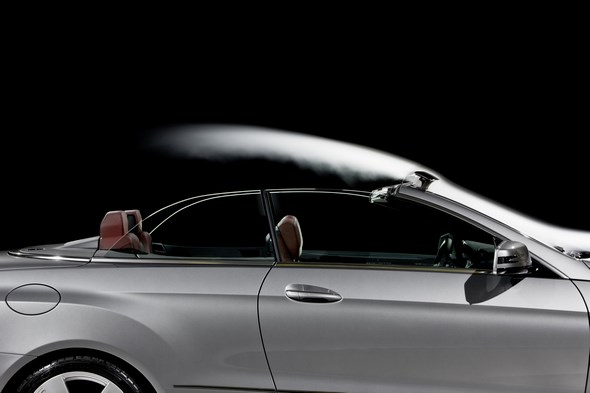
The A-pillars were completely redeveloped and brought around a 50 percent higher strength than the version previously built. In addition the windscreen was glued into the frame to increase strength. This resulted in considerable resilience in the roof-drop test, meaning that the open-top car was even permitted without targa bars in the USA. The rear window in the hardtop was also glued. There were groundbreaking new products and features in the interior too. The dashboard yielded on impact and was padded with foam both in the upper and in the knee area. Also new was the four-spoke steering wheel, built in accordance with the accident researchers’ findings. The proven dashpot remained, but the steering wheel rim, the four spokes, padded boss of the steering wheel and hub were covered with polyurethane foam. A telescopic safety steering column and the steering gear situated behind the front axle supplemented the safety measures beneath the sheet metal panel. The vehicles had three-point seat belts as standard. The door handles were also redesigned in such a way that even after accidents they did not spring open of their own accord, but could still be opened by hand.
All the cabriolets and roadsters from Mercedes-Benz Cars
The dream car initiative
2016 is the year of dream cars for Mercedes-Benz Cars. No other manufacturer offers so many and such young cabriolets and roadsters. The current range extends from the smart fortwo cabrio through the C-Class, E‑Class and S-Class Cabriolet to the modernised SL and SLC Roadsters.
The youngest member of the open-air family is the first cabriolet on the basis of the C-Class. It thus rounds off the cabriolet palette with a classic fabric top. The new cabriolet’s design interprets modern luxury with a youthful touch. Featuring plenty of high-quality details, its distinctive character is most apparent when the top is down. The cabriolet is optionally available with the automatic draught-stop system AIRCAP and neck-level heating system AIRSCARF – for exceptional comfort during open-top driving 365 days a year.
Efficient, powerful engines delivering 115 and 270 kW (156 to 367 hp) and a suspension designed for dynamics (with optional AIRMATIC air suspension) ensure sportily agile handling. The new 9G-TRONIC automatic transmission is available for all engine variants. Also on board: proven assistance systems and state-of-the-art infotainment.
The Mercedes-Benz SL: the legend – now even more dynamic
New appearance for an automotive icon: the extensively technically and visually optimised Mercedes-Benz SL has been here since April 2016. More powerful engines, the automatic transmission 9G-TRONIC, DYNAMIC SELECT with five transmission modes and Active Body Control with the curve tilting function all take the legend to a new dynamic level. Its suitability for everyday use has been enhanced with a soft top which can now be operated at up to 40 km/h when starting off, and the automatic boot separator. Visually the front end in particular has been made significantly sportier and includes a new bonnet, new bumpers and new headlamps.
The Mercedes-Benz SLC: new name, new dynamics
To coincide with its 20-year anniversary, the archetypal compact roadster is to be relaunched with a new name – the SLC – as well as significantly further developed technology and an enhanced look. The name change acknowledges the close relationship with the C-Class.
There are new additions to the model line-up – the sporty top-of-the-line Mercedes‑AMG SLC 43 and the entry-level SLC 180. In visual terms, stand-out features include the standard-fit diamond radiator grille and the LED Intelligent Light System (optional extra).
The Mercedes-Benz S-Class Cabriolet: open-top luxury
The cabriolet is the sixth variant of the current S-Class family, and the first open-top luxury four-seater from Mercedes-Benz since 1971. It offers a distinctive, sensual and exclusive design, the cutting-edge technology of the S-Class and a comprehensive warmth and wind protection concept which includes intelligent climate control for cabriolets. A loving attention to detail is also evident in the luggage compartment concept: when the soft top is opened, it folds away into a section of the boot. In the boot the soft top is separated from the remaining boot capacity by means of an electrically operated retractable cover which encloses the soft top.
The Mercedes-Benz E-Class Cabriolet: accomplished refinement
With intelligent and efficient engineering plus luxuriously comfortable appointments, the E-Class Cabriolet is designed for passionate driving enjoyment. Fully retractable side windows characterise the four-seater cabriolet and emphasise its clear proportions with the beltline which climbs slightly all the way from the front to the boot lid. The classic fabric roof lends it an exclusive elegance.
Six petrol engines rated at 135 kW (184 hp) to 300 kW (408 hp) plus three diesel engines rated at 125 kW (170 hp) to 190 kW (258 hp) are available. Plus there are two unique special models: the “Sport Edition” with sporty details in the exterior and interior and the “V8 Edition” with exclusive equipment.
The new smart fortwo cabrio: summer in the city
The new smart fortwo cabrio heralded a very special variant of the new model series in March this year. At the press of a button the new smart fortwo cabrio transforms from a closed two-seater into a car with a large sliding canvas sunroof. Or it becomes a cabriolet with a completely opened soft top.
This enables the fresh-air driving experience to be adapted to the weather or the driver’s mood. This flexibility made possible by the “tritop” folding sunroof and removable roof struts is a special feature not only in this segment. At the same time, the new smart fortwo cabrio is the only true cabriolet in its vehicle class.
Since July the smart fortwo cabrio has also been available in the BRABUS version with a 80 kW (109 hp) turbocharged engine. It also boasts the BRABUS performance sports suspension with specially adapted ESP®, the BRABUS sports power steering and sporty configuration of the twinamic dual clutch transmission with Race Start function.

